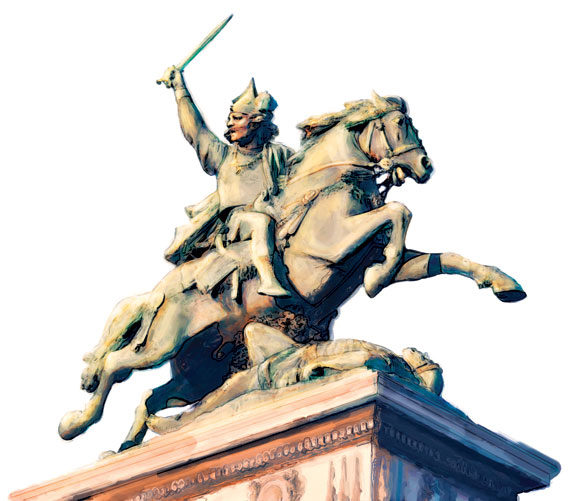A giant statue of a warrior on horseback stands in the place de Jaude, the central square in Clermont-Ferrand, France. This is no figure sitting on a stationary horse, but of a man with sword drawn, the horse in full gallop. The image is so vivid it is easy to imagine it rapidly moving on. Sculpted by Frédéric Auguste Bartholdi, known to Americans as the man who designed the Statute of Liberty, the great rider is Versingetorix, (vers-n-ge-to-rex) “Great Warrior King,” a man that united the Gallic tribes (in what is now more or less France, Switzerland, Austria and Germany) against a foreign invader.
His reign was short-lived. After severely defeating Julius Caesar at Gergovia, Vercingetorix retreated to the stronghold at Alesia, a hilltop fortress. Caesar regrouped and chased Vercingetorix to Alesia. The Roman Senate gave Caesar an imperium as governor of Gaul with unlimited power in that province.
So long as Rome and Italy were protected from enemies and the treasuries were filled with booty, the Roman Senate more or less let those holding imperium in the provinces do whatever they wanted. And the governors did.
The Gallic tribes populated the Alpine region, separating Italy from the rest of Europe and from the Rhine to the Atlantic Ocean and even into England. The tribes were warring and threatening Rome and Italy.
Caesar, with several legions (about 6,000 men) and several auxiliary cohorts, traveled as far east as the Rhine River and as far west as Spain and as far north as England in an effort to defeat the Gallic tribes.
Despite Roman victories, the tribes continued to resist. In one battle, a Gallic army destroyed the XIV Legion, a devastating and demoralizing defeat for Rome and Caesar.
In 53 to 52 BC, Caesar wintered across the Alps just to the north of Italy; Gauls were going settlement-to-settlement and slaughtering Romans. The tribes came together for a council and agreed to unite against Rome. They chose Vercingetorix or “Great Warrior King” as their leader.
Through the winter, spring and summer of 52 BC, Caesar chased Vercingetorix and engaged him in several battles. In at least one of those, Gergovia, Vercingetorix forced Caesar to withdraw or suffer total defeat.
Though it was a victory, Vercingetorix did not think he could make the final victory and decided to rest and regroup at the hilltop, and easily defended, Alesia.
Caesar ordered his men to encircle the fort. Working night and day, the Roman army dug two parallel ditches each about 15 feet across and deep. The dirt was piled opposite the fort. Atop that mound (over 10 miles in circumference), they stood logs.
They flooded the ditch nearest the new barricade and installed other traps to slow or stop an assault from the Gallic army.
Before completion of the fortification, some of those trapped on the hilltop escaped. Caesar knew they would seek reinforcements, so he built a second fortification just like the first one but facing out.
This new barricade was about 14 miles long and put the Romans in the middle fully able to defend any efforts to stop the siege.
The reinforcements had to come through the outside barrier before they could relieve the siege victims. Laying siege to the Romans would spell certain doom to those on the hilltop.
The fortification was called a circumvallation and the second a contravallation. Both were, in military terms, investments, the latter term from the basic meaning “to cover to envelope something.”
In the battle for dairy profitability, the siege mentality can easily set in. Producers want more; plants want to pay less. Historically, in response to receiving too little, producers have obtained protection from the government through pricing and pooling orders.
These investments are designed to protect the producers, but are they keeping the plants out or the producers out? On what side of these investments do the producers dairy?
An example of how this uncertainty unfolds came out in recent hearings for the CDFA. Years ago producers helped establish a milk pricing and pooling system in California that has, over the decades, allowed it to grow and profit.
The pricing is based upon the sound premise that milk from the farm is only worth what the consumer will pay for it finished, less the cost to make that product. An investment was created that required plants pay a minimum price using formulas from that premise.
When it was bottled milk and cheese, it was easy. Then came powder, then different cheeses and now whey.
Recently CDFA changed the minimum price formulas by raising the sales adjustment for butter (raising the butterfat price), increasing the manufacturing allowance for butter (lowering the butterfat price), raising the make allowance for NFDM (lowering the 4a price) and adding additional whey adjustment (raising in some markets the 4b price).
Whey, a byproduct of making cheese, has value. The value comes from a capital commitment from the plant and marketing the different kinds of whey. If the premise is that producers receive what the milk produces less cost, then whey should be included.
Why is pricing whey in government formulas a problem? The answer is this: While every cheesemaker makes cheese from milk and has a whey byproduct, not all can convert the whey stream into value.
According to CDFA, only 12 of the 58 cheese plants in California processed whey. But at the same time, cheese plants that processed whey produced 82 percent of the cheese produced in 2010.
Some of these plants make whey protein concentrate, some merely dry it, and some merely dispose it as a waste. The processed whey sells at higher prices for human consumption and lower prices for animal feed.
Each of these whey processes yields different values. While, in general, the WPC is worth more than dry whey, which is worth more than dumping, that is not always true.
In 2007, dry whey greatly exceeded the value of WPC, putting a lot of large cheese plants in a financial pinch because they were paying for whey based upon higher-value dry whey and selling it at lower WPC. In 2009, it was turned around and those who made dry whey did so at a loss compared to those who just dumped it.
The FMMO Class III skim includes 5.9 cents for every cent of dry whey net of manufacturing allowance. For the first six months of 2011 it has added over $1 to the Class III price.
In July it was about $2. Since its first use in 2000, the other solids has provided an average 75 cents over using just the cheese price, with as much as $3.50 and reductions as low as 27 cents (it can go negative).
California fixed a whey adjustment at 25 cents. For several years it did have an end-product pricing formula for whey, but too little data on cost of manufacturing resulted in wild ranges of value and CDFA abandoned it.
In 2009, the 25 cents was more than the FMMO’s discount, but as whey prices have strengthened the disparity between the higher FMMO Class III and California 4b have grown – according to CDFA, since 2010 Class III has exceeded 4b an average $1.31.
This has been hard on California producers but has also provided a competitive advantage to California cheese plants. The new CDFA rule adjusts the investment to let producers get more whey value with a flexible formula ranging from 25 to 65 cents, depending on the dry whey price.
As far as moving the investment, this has been in California producers’ favor, but only in a small way. At the same time, they face another challenge.
Caesar recognized that he had to build investments for both the siege – against those in the fort – and to protect his soldiers – from reinforcements from the rear. In the end, that was the genius of his plan and the basis for his victory.
Dairy producers are facing a feed challenge. Not one just of cost, but of availability. As the 2010 crops are used up and the 2011 crops fill their place, the extended drought in Texas and other areas, heavy rains in the Northeast and other weather disasters will likely expose a shortage of feed, particularly forage.
That means prices for feed will increase. If finished good prices do not also rise, then dairy producers will be challenged on both sides of their investments, just like in 2009.
Then it was a courageous and hard fight by producers to keep dairying. By and large, they succeeded, but not without severe losses and casualties.
Caesar was squeezed between enemy forces. The Gallic reinforcements came. Separation from those in the fort denied coordinated attacks. Breaks in the barriers were found and the tribes poured in.
Sheer effort and heroism of the Romans with the personal leadership from Caesar and Mark Anthony brought success. Seeing the reinforcements defeated, Vercingetorix surrendered. This brought an end to the rebellion by the Gallic tribes.
After the victory at Alesia, Caesar had effectively made Gaul, from the Rhine to the Atlantic and into England, a secure Roman province – a status that lasted over 300 years. With the wealth from six years of victories in the Gallic wars and a trained army loyal to him, Caesar demanded the Senate give him a triumph, the right to parade his army and spoils through the city of Rome.
Under a Roman law, a provincial governor with imperium had to surrender the imperium and disband the army before crossing into Italy as defined by the River Rubicon. Not only did the Senate refuse, but ordered him to stand trial for various criminal charges.
Caesar crossed the Rubicon with his imperium and his army. The Roman Civil War resulted.
In the end, Caesar was the leader of Rome and dictator in perpetuity. The Roman Republic ended and the Roman Empire began.
Finally, in 46 BC he received the triumph. Vercingetorix, in his finest, was paraded through the streets of Rome and then, as was customary, strangled to death in prison.
Eight hundred years later, Charlemagne united the Franks again, but two millennia later Vercingetorix remains a hero. At the base of the statue in Clermont-Ferrand, translated into English, “I took up arms for the liberty of all.” PD

Ben Yale
Attorney
Yale Law Office ben@yalelawoffice.com







